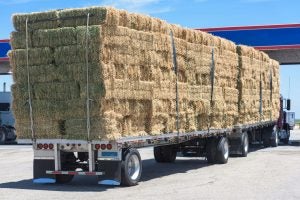Landowners and agricultural producers are beginning the recovery process by assessing damages left in the wake of the Smokehouse Creek fire and other fires in the Texas Panhandle.
It is important for those who suffered damages to know there are resources available to help in the rebuilding process, said Tiffany Lashmet, J.D., Texas A&M AgriLife Extension Service agricultural law specialist, Amarillo.
Among those resources are AgriLife Extension-operated Animal Supply Points where affected producers can obtain donated hay, feed, milk replacer and fencing supplies. Those who suffered any type of loss are encouraged to make use of the many material donations that have arrived at these locations.
However, Lashmet said there are other assistance programs ranchers might not be aware of that can be utilized in their recovery.
“A part of the service we offer is educating producers that there is help available, not only through our programs, but through USDA as well,” she said. “Our row crop farmers may be familiar with FSA programs, but historically that has not always been true for rangers. We want to make sure they are aware of what programs are available and what to ask about when they explore their options.”
Programs designed to assist disaster recovery
There are several programs through the U.S. Department of Agriculture, USDA, Farm Service Agency, FSA, that may be available to assist producers who have suffered losses on their land or with livestock and fences due to the fires.
Lashmet said these programs are important to help producers who face natural disasters.
“The best thing you can do is go in and talk to representatives at the FSA office,” she said. “They will know the details about what is available and how best to help you.”
In the meantime, she reminded affected landowners and operators to gather whatever records may be of use toward recovery.
“Having documentation like records and receipts that can show what livestock you had and what you lost is important when you go into these offices,” Lashmet said. “It might be sale barn receipts or records of calf births or cell phone pictures of losses, but gathering as much as you can as you go through this process could help qualify for one of these programs.”

Applicable USDA programs
Affected landowners and livestock producers can inquire at their local FSA office. Staff members at local FSA offices will be able to provide more information and details on each program and help determine potential eligibility.
- Livestock Indemnity Program, LIP, aids with livestock losses due to disaster, including wildfire. LIP provides indemnity payments for livestock killed in fires, for livestock that had to be euthanized as a direct result of the fires, and for livestock injured by the wildfire that is sold within 30 days for a reduced rate. The payment rate for 2024 losses will be released later this month. Producers must provide records of their losses, including inventories, financial records, photographs, rendering receipts, and veterinary certifications. The deadline to provide notice of loss and a payment application is 60 days after the calendar year the loss occurred, which would be March 1, 2025.
- Livestock Forage Program, LFP, is not specifically wildfire-related but assists livestock producers who have suffered grazing losses due to drought during the normal grazing period. For example, producers may qualify for LPF payments if a drought is declared in their area. The 2024 LFP payment rates will be released in April. The deadline to apply for LFP for 2024 losses is Jan. 30, 2025.
- Emergency Assistance for Livestock, Honey Bees and Farm-Raised Fish, ELAP, assists with a variety of losses related to wildfire including certain grazing losses, feed costs and transportation of livestock, feed and water. Producers have until Jan. 30, 2025, to apply for ELAP.
- Emergency Conservation Program, ECP, provides cost-share assistance to repair or replace certain conservation structures damaged by wildfire. Qualifying structures may include fences and watering facilities. The ECP cost-share is 90% for underserved producers and 75% for all other producers. ECP has an ongoing, localized deadline, so landowners should check with their local FSA office for more information.
- The FSA may authorize emergency haying and/or grazing of Conservation Reserve Program, CRP, acres to support areas impacted by wildfire including the relocation of livestock for grazing purposes. The details on where and when this may be available differ by county, so producers should contact the local FSA office for additional details.
- The FSA has an emergency loan program offering loans to affected producers at an interest rate generally lower than other lenders. The requirements and details of these loan programs are available at the local FSA office.
- Environmental Quality Incentives Program, EQIP, is administered by the USDA Natural Resources Conservation Services office and offers financial assistance to landowners to address certain natural resource concerns. This program, while not disaster specific, could potentially be an option for producers seeking to implement certain conservation practices. In some instances, building fences may qualify for EQIP funding.
This article was provided courtesy of Texas A&M AgriLife Today.


